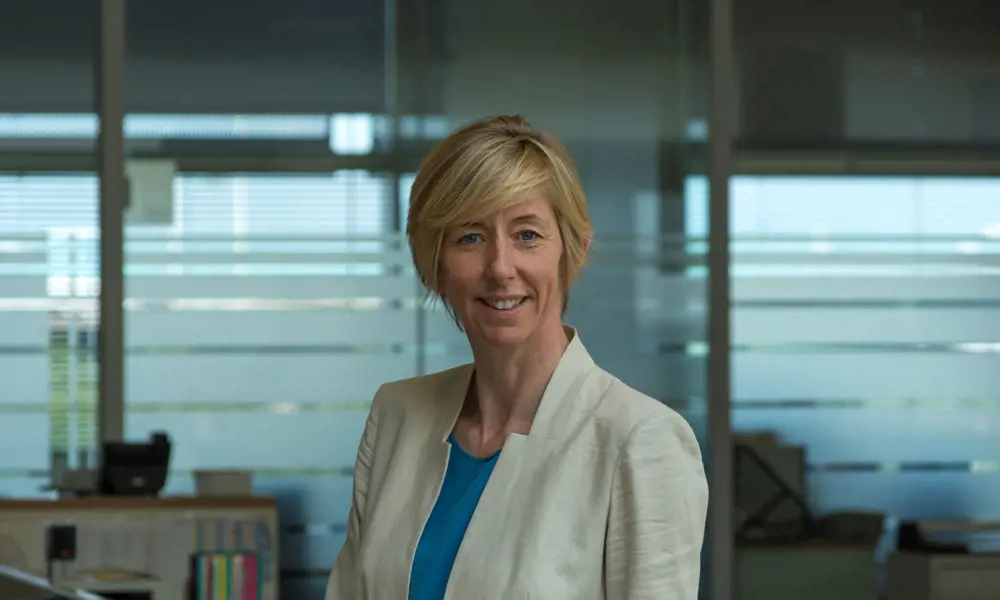
Foundations for a construction revolution
In her early years as a researcher, Dr Sarah Williamson FREng was happiest investigating the behaviour of reinforced concrete through structural testing – creating and destroying pieces of the material, the larger the better. Today, as Construction Technical Director at BYLOR – a joint venture between Laing O’Rourke and French construction company Bouygues Travaux Publics – she holds significant responsibility for the delivery of Hinkley Point C, one of the largest civil engineering projects in Europe.
Dr Williamson wants to dismantle the construction industry’s traditional approach to planning and executing projects. She even objects to the ‘construction’ label: “We shouldn’t talk about construction, we should talk about manufacture and assembly,” which she would like to see guided by digital representations and new ways of working onsite.
She even objects to the ‘construction’ label: “We shouldn’t talk about construction, we should talk about manufacture and assembly,” which she would like to see guided by digital representations and new ways of working onsite
Dr Williamson’s experience of construction sites started young. Her father ran his own building business, assembling sports facilities and houses in Cumbria. “From an early age, I spent as much time as could with my dad onsite,” she says. “I had my own tools and became an expert at brick stacking and sweeping up.” However, the experience did little to evoke an early interest in an engineering career. She admits to knowing nothing about the subject when she was at school, so opted to study the A levels that she found easiest and most interesting: English, French and geography.
No-one else in Dr Williamson’s family had attended university and she admits that she found the idea of it intimidating. Therefore, she chose to join her father onsite. “At age 18, I was working on small building sites, responsible for myself and the work of a small number of men,” she explains. “That was an amazing experience. Just imagine what it was like as a woman of that age in the 1980s, I loved it!” After three years, Dr Williamson changed her mind about university, as she puts it: “cold winters and hard skin prompted a rethink about education.”
Returning to academia
Her first step was an engineering foundation course at Preston Polytechnic. This enabled her to get on the right track and study a degree in civil engineering. She then spent four years at Liverpool Polytechnic, emerging with a first-class degree and a clutch of prizes.
Dr Williamson set out on a career that has been anything but predictable. Indeed, she says with a hint of amusement that she has been accused of having a CV that was starting to look “a bit bitty”. Her response to such comments is: “well, you only live once. Throughout my life, I have done what I find interesting and useful. I enjoy ploughing my own furrow and it is advice that I give to young engineers in the team. We live and work in a changing world where flexibility, adaptability, and the ability to think and problem solve are much more important than 10s of years of solid experience in the same field.”
you only live once. Throughout my life, I have done what I find interesting and useful. I enjoy ploughing my own furrow and it is advice that I give to young engineers in the team
After university, uninspiring job offers and a construction industry in one of its regular recessions left Dr Williamson looking for something interesting to do. The suggestion of a PhD piqued her interest and gave her the opportunity to experience a very different kind of environment; moving from a polytechnic in Liverpool to a leafy campus at the University of Birmingham.
She began a PhD project on a topic that has been a consistent theme in her professional career: reinforced concrete and its material properties and structural behaviour. Thanks to problems on Birmingham’s highways, the topic of reinforcement corrosion was of local interest at the time. She spent three years “mostly making and breaking small specimens of reinforced concrete” as she set out to understand how corrosion of reinforcement affected structures and what it would take to protect reinforcement from corrosion.
There is nothing like trying to explain difficult structural concepts to a bunch of 18- and 19-year-olds when you’re only 26 yourself
Then came another of those ‘follow your interests’ moments. As Dr Williamson’s PhD was ending, the head of the university’s concrete structures research group, Professor Les Clark OBE, was elected President of the Institution of Structural Engineers. The university offered her a lectureship to help cover the period when Professor Clark would be away. Still in her mid-20s, Dr Williamson saw it as an amazing challenge: “There is nothing like trying to explain difficult structural concepts to a bunch of 18- and 19-year-olds when you’re only 26 yourself.”
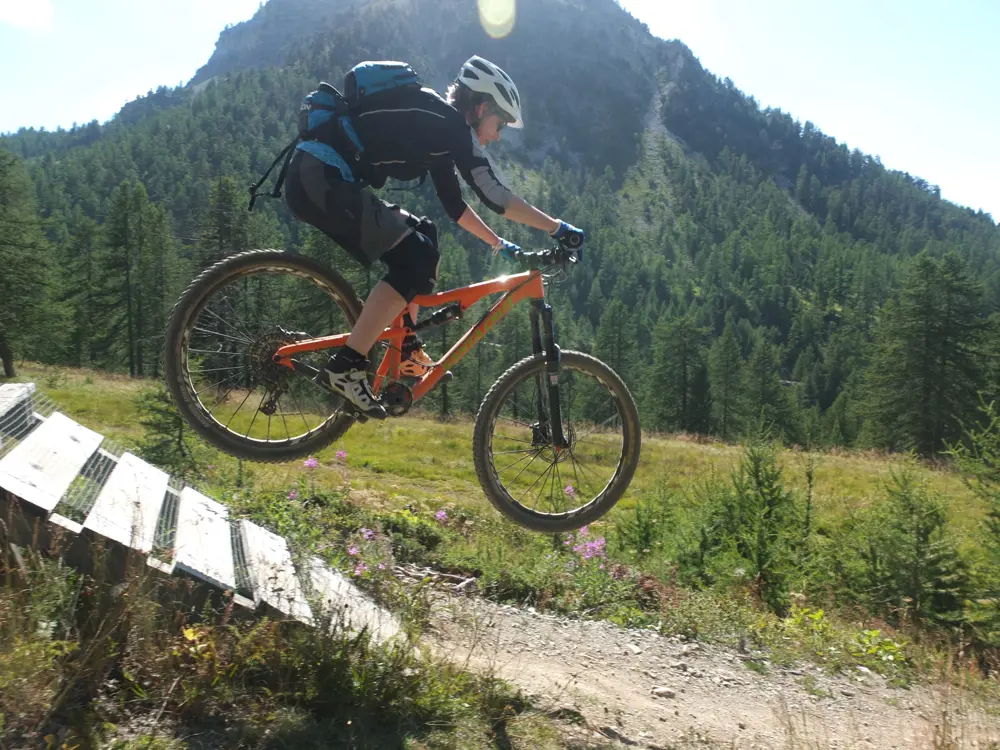
Dr Williamson’s role as chief engineer at Atkins was based in Cumbria, where she built up a team of people doing head office work in the rural location. This also, of course, gave her the opportunity to make the most of the setting through activities such as yoga, walking and mountain-biking
A move into industry
Over the next few years, Dr Williamson spent time in both industry and academia. She moved north to work with Mott MacDonald, then spent time at the University of Salford, and finally returned to Birmingham. She aspired to become a chartered structural engineer and decided that it was time to both move into industry and go home to Cumbria. She joined Atkins as a senior structural engineer in a team of four. Within nine months, Dr Williamson was leading that team, which grew in both size and diversity over the next six years. During her time at Atkins, she went on to become chief engineer, leading teams of civil and structural engineers in projects on nuclear facilities all over the UK. This seems to have been enjoyable work, not least because it was based in a pleasant setting in Cumbria. But that location itself could have caused problems in a business that is often big-city centric. Dr Williamson set out to counter that tendency.
Dr Williamson’s role as chief engineer at Atkins was based in Cumbria, where she built up a team of people doing head office work in the rural location. This also, of course, gave her the opportunity to make the most of the setting through activities such as yoga, walking and mountain-biking
“The office was in a rather inaccessible location – some might say the back end of beyond,” she says. “My idea was that you should not have to give up living in a beautiful and rural location to do exciting work. At the time, the two were generally mutually exclusive with the most exciting projects being delivered out of city offices. My plan was to build a team capable of doing that work and stop it from going to the big offices.” Dr Williamson came up with a label to describe her thinking: “Our strapline was ‘head office work in a rural location’.” It seems to have worked: what started with four people became a team of 30, working for nuclear clients all over the UK. “That team is still up there. I am really proud of what we achieved and what it continues to achieve.”
Our strapline was ‘head office work in a rural location’.” It seems to have worked: what started with four people became a team of 30, working for nuclear clients all over the UK
This thinking was in line with Dr Williamson’s growing awareness of the need to develop teams. “There are three parts to my job,” she explains. “There is the technical bit – I am a technical person out and out. Then there is communication.” The other part, she says, is: “looking after and nurturing the team. I get great satisfaction from seeing people grow and develop and watching teams gel and evolve together.”
Dr Williamson sees team building as a fundamental part of an engineer’s professional toolbox. “In my 30s, I became very aware that leadership and communication skills are every bit as important as, perhaps more than, the technical skills.” Now working in a UK/Franco joint venture in a team with over 20 nationalities, these skills are vital. “We have to create an environment where everyone, regardless of background or nationality, understands the project, their part in the project, and feels valued and respected – that takes real commitment.”
Digitising construction
In 2012, Dr Williamson joined Laing O’Rourke’s Engineering Excellence team in a role that included development of digital engineering techniques. She is now Construction Technical Director at BYLOR, responsible for construction engineering at Hinkley Point C, the UK’s first nuclear power station since Sizewell B started operations in 1995.
Dr Williamson is very clear that digital technology is key to delivering the project. “Paper drawings are rarely used onsite,” she adds. “The full team, which includes engineers and supervision, uses tablets and field stations with computer screens to study digital representations of the structures that they are assembling.”
There is so much opportunity to change the way we work, using technology and data. From that, comes the opportunity to attract more and different types of people into our industry
The move to digital technology is part of Dr Williamson’s campaign to rewrite the handbook for construction projects. “The thing that gets me up every morning is changing the construction industry,” she explains. “There is so much opportunity to change the way we work, using technology and data. From that, comes the opportunity to attract more and different types of people into our industry.”
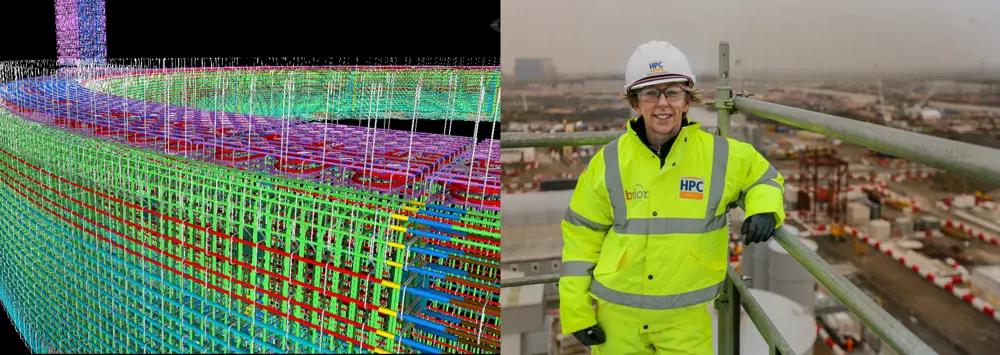
On the Hinkley Point C project, everything that is going to be built is first created in a model. “We want the model information, because we want to use that to totally change the way that we go to work on site. There are models for everything; all the roads are modelled, all the cranes are modelled, everything is built on the model, not just because it looks really nice but because it allows us to properly plan our work.”
Her first move would be to ditch the ‘construction’ label, saying that it is just a part of a process that comes after the extensive design work and planning that must be completed before anyone can move on to a site. “I am really passionate about integrating design and construction,” she adds. “The two should go in absolute harmony, so that by the time that you get to site, what happens is a structured assembly process rather than the more complex and emergent traditional construction process.”
The process starts by sitting down with the client. “I spent four years working with the designer and client in the design phase,” Dr Williamson explains. Living in Kent at the time, she made regular visits to EDF Energy’s engineers in Paris. The EPR, a third-generation pressurised water reactor, is she says, “a challenging structure to build”. It has certainly seen construction delays on other sites. “EDF was very determined that this time it would be done differently. As we are the main civil works contractor, they engaged with us early to explore the opportunities offered by digital engineering.”
To make that happen, Dr Williamson turned to the digital techniques that she pioneered at Laing O’Rourke. “One of our first challenges was to understand whether it would be possible to detail the reinforcement in three dimensions. Modelling a few bars is simple but contemplating preparing production information for quarter of a million tons of reinforcement using this technique was a different proposition,” she explains. “After some significant effort, we came to the conclusion that yes, it is.”
In practice, the team building the model ensures that it includes inputs from the constructor as well as the designer. Everyone works together to ensure that the end product is buildable
There was a lot of talk about ‘collaboration’ but what does that really mean? “The language that we use is about meeting the needs of the designer and the constructor.” In practice, the team building the model ensures that it includes inputs from the constructor as well as the designer. Everyone works together to ensure that the end product is buildable. “We take a design, we check that we can build it,” Dr Williamson explains. “We call it a virtual build, or an assembly check, and that is a real thing, it is not something that we do for a presentation. We do our assembly checks so that we know that the thing will go together.”
Models are only as good as the information that goes into them. Building the model is a complex process. “We specify to the client what we need to see in the model in terms of data,” she adds. “The model is a representation of a series of databases.” It covers just about everything that is done onsite. “Having that one-to-one scale model is the best way to control the inventory of material that you bring to site. If you model it, that means you need to buy it and you need to put it where you showed it in the model. You should end the project with not one more or one less component than you put into that model.”
The model data supports all the site processes, which is why tablets are ubiquitous – used by steel-fixers, for quality checks, and to call off materials. The digital approach also has advantages for regulators. All construction projects should be built to the required specification, but nuclear projects have a regulatory requirement to demonstrate this. The feedback from regulators so far has been good. “The regulator focuses in several key areas: two of these are process control records. Our use of the model and field technology allows clear visibility of how we control the construction sequence and generate digital quality records. They see this as a real positive.”
we have a real opportunity to maximise the use of technology and data to support the project’s delivery, as well as a change in the industry
To get to this stage, the engineers at Hinkley Point C had to go back to basics. “We need everyone in the team to understand the importance of quality and make sure that 100% of the time the focus is on getting it right. Because of the size of the project – and because the client has been progressive in the way of thinking about how they will give the information to us – we have a real opportunity to maximise the use of technology and data to support the project’s delivery, as well as a change in the industry."
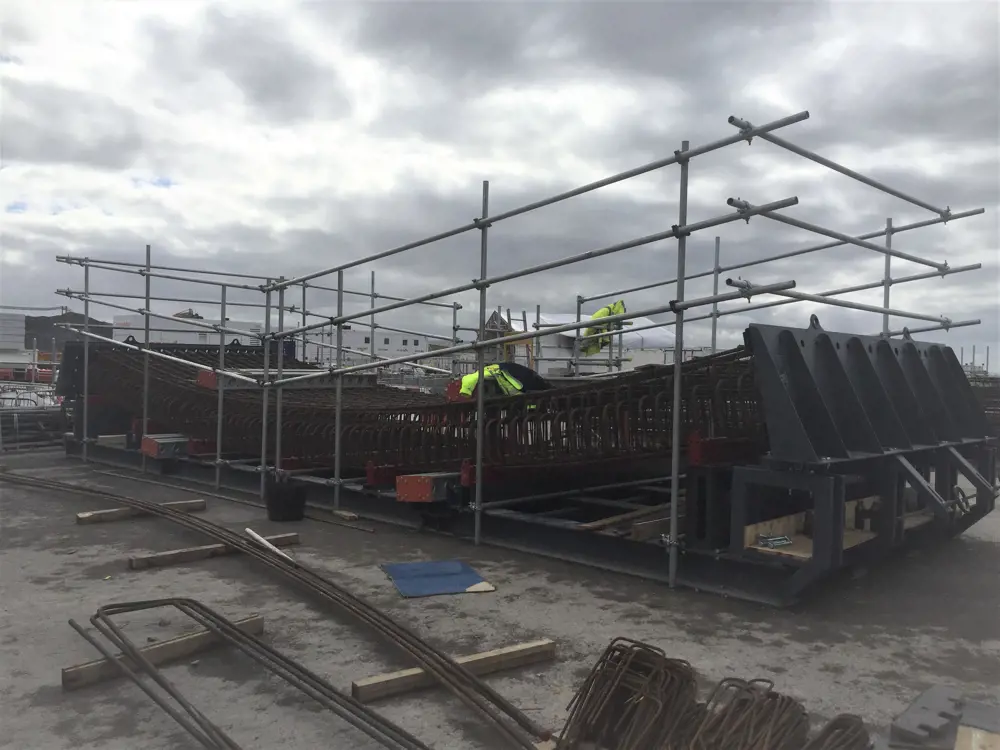
At Hinkley Point C, the welding is carried out at a separate fabrication facility. This approach to assembly is something that Dr Williamson feels will be instrumental in industry change
Time for change
Dr Williamson’s passion for integrating design and construction is just the start of the quiet revolution that she advocates in the battle cry “manufacture and assemble”. In this new approach, the old way of design and construction gives way to design, manufacture and assemble. The approach is “a kit of parts”, she says. “The aim is to plan and organise the components that need to be assembled then hand over with a full set of instructions.”
For example, the model behind Hinkley Point C will ensure that the many miles of steel reinforcement arrive on time and in the right quantities, but this will not be taken to its final location for fixing, Instead, it will go to a separate fabrication facility to be turned into cages, which will later be installed in the final position. This is so that the cages are manufactured in a controlled environment where it is much easier to control the process and the quality. As Dr Williamson describes it: “One of our key principles is componentisation. The traditional construction process requires piecemeal installation of many elements. Our aim is to minimise the number of components required to form the final structure and thereby simplify the process of assembly. The components can be manufactured in more controlled environments.” The construction industry has a label for this plan to move welders into their own ‘factory’, it describes the process as ‘componentise and assemble’. “This a key concept,” says Dr Williamson. For her, it is a driver for industry change.
Our aim is to minimise the number of components required to form the final structure and thereby simplify the process of assembly. The components can be manufactured in more controlled environments
Dr Williamson foresees significant changes in the shapes of the teams needed for construction projects of all sizes. To begin with, everyone on a project will need the skills required to develop, and use, those all-important computer models. “Sometimes people think that model-based working is for specialists.” She disagrees. “We call it digital content and we are increasing it in many of our roles, creating new skill sets in existing teams and recruiting roles that would not normally be seen in construction teams, such as data engineers and analysts.”
Diversity in engineering
As a woman with a senior role in engineering, Dr Williamson naturally finds herself called on for her views on gender issues. She is happy to play that game, but takes a broader view on the bigger topic of diversity. Forget about ticking boxes, she insists: “It is not about meeting quotas, it is about a fundamental right to equality for all regardless of background, gender, ethnicity, or anything else. In terms of business success, for me, it is simple: diversity is a key ingredient in teams that are creative and successful, and therefore necessary.”
for me, it is simple: diversity is a key ingredient in teams that are creative and successful, and therefore necessary
Dr Williamson sees her own career as an example of this broader diversity. She now takes pride in those comments about her ‘bitty’ CV, with its relatively late conversion to engineering and that ‘polytechnic’ first degree, followed by moves in and out of academia and a rapid rise in industry working in different businesses. “I think that what I did is a great model: some practical experience, some broadening and then do some deepening in a technical subject. It almost sounds like it was a plan!” She sees nothing wrong in recruiting undergraduates with arts A levels, and what is the fixation with degrees? “A lot of the roles that we need to deliver a big civil project do not need a degree,” she insists.
Dr Williamson would rather recruit people who can learn. “What I am really trying to do is to bring people in to do jobs that we can train them to do relatively quickly, either through off-site or onsite training, and then give them the opportunity to progress if they have got the aptitude and the desire,” she says. “I just love the idea of giving people the opportunity to really fulfil their potential.”
I just love the idea of giving people the opportunity to really fulfil their potential
Career timeline and distinctions
Born, 1969. Awarded a degree in civil engineering from Liverpool John Moores University, 1995–1999. PhD in structural engineering at the University of Birmingham, 2000–2003. Lecturer in structural engineering at the University of Birmingham, 2003–2006. Member of the Institution of Structural Engineers, 2006. Chief Engineer at Atkins, 2006–2012. Technical Director at Laing O’Rourke, 2012–present day. Fellow of the Royal Academy of Engineering, 2017.
Dr Williamson sees Hinkley Point C as a test bed for this new way of thinking about construction projects, regardless of their size and complexity. “My idea is that we will deliver the project, it will be successful, and that the people who come out of it will have a very different idea of what a construction project looks and feels like.” It is also part of Dr Williamson’s grand plan to take this “once in a lifetime” opportunity to change the industry’s thinking. “I am not going to say that it will change the industry in one go, but it really will open up people’s eyes as to how we can go about construction in a different way.” As a senior member of the Institution of Structural Engineers, she is taking her message beyond Hinkley Point C and her current job.
Spreading the word seems to be as important to Dr Williamson as completing Hinkley Point C. “I have spent five years of my life pushing this new way of going to work in construction. Step one was to get the design delivered in the way that suits our working practice. Step two is to demonstrate that we can implement those working practices and that they make a difference.” At the end of the project, she adds: “We will have a team that looks and feels different to a traditional construction team, that works differently, and is motivated and constantly hitting the targets, getting safety right, getting quality right.” That would certainly lay down some evidence-reinforced foundations for a revolution in construction in the UK.
***
This article has been adapted from "Foundations for a construction revolution", which originally appeared in the print edition of Ingenia 75 (June 2018).
Contributors
Michael Kenward OBE
Author
Keep up-to-date with Ingenia for free
SubscribeRelated content
Civil & structural

Building the Shard
The Shard is one of London's most iconic buildings. The tallest in Western Europe, it was designed by Italian architect Renzo Piano and dominates the city’s skyline. Ingenia spoke to John Parker, project director for structural engineers WSP, who outlined the engineering decisions made in building the enormous steel and glass structure.
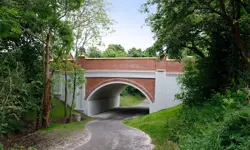
FlexiArch
Arch bridges are strong, durable and require little maintenance. However, very few had been built since the early 1900s until the FlexiArch was developed and launched in 2007. Now, there has been a minor renaissance for this ancient form of construction.
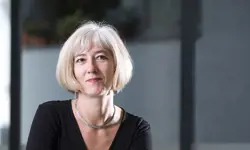
Creating user-friendly buildings
For Michelle McDowell, a former Business Woman of the Year, a passion for joined-up design thinking and building information modelling with a user-friendly approach has enabled her to pioneer revolutionary changes in her field.

Troja Bridge
In November 2014, one of the world’s largest network arch bridges was officially opened in Prague. The UK may soon have its first network arch bridge if the go-ahead is given for a new rail project in Manchester.
Other content from Ingenia
Quick read

- Environment & sustainability
- Opinion
A young engineer’s perspective on the good, the bad and the ugly of COP27

- Environment & sustainability
- Issue 95
How do we pay for net zero technologies?
Quick read

- Transport
- Mechanical
- How I got here
Electrifying trains and STEMAZING outreach

- Civil & structural
- Environment & sustainability
- Issue 95